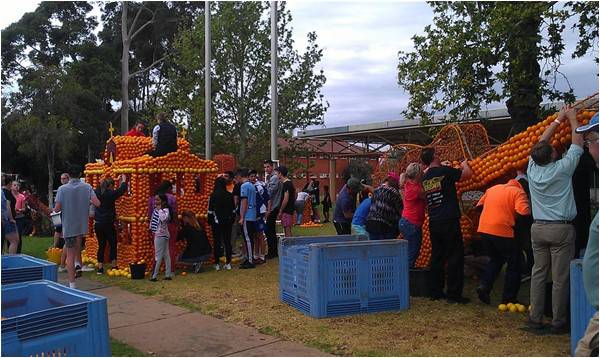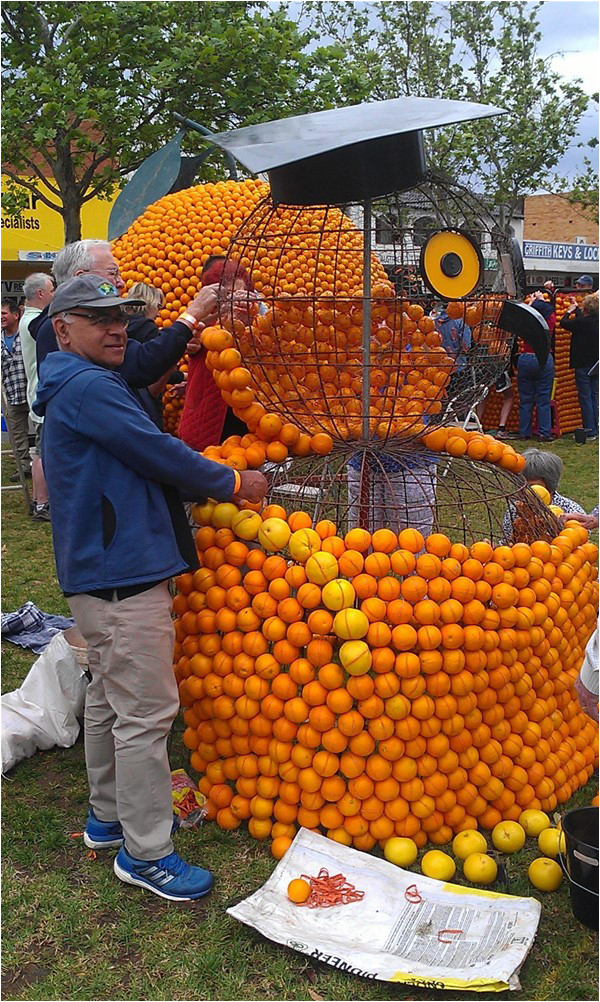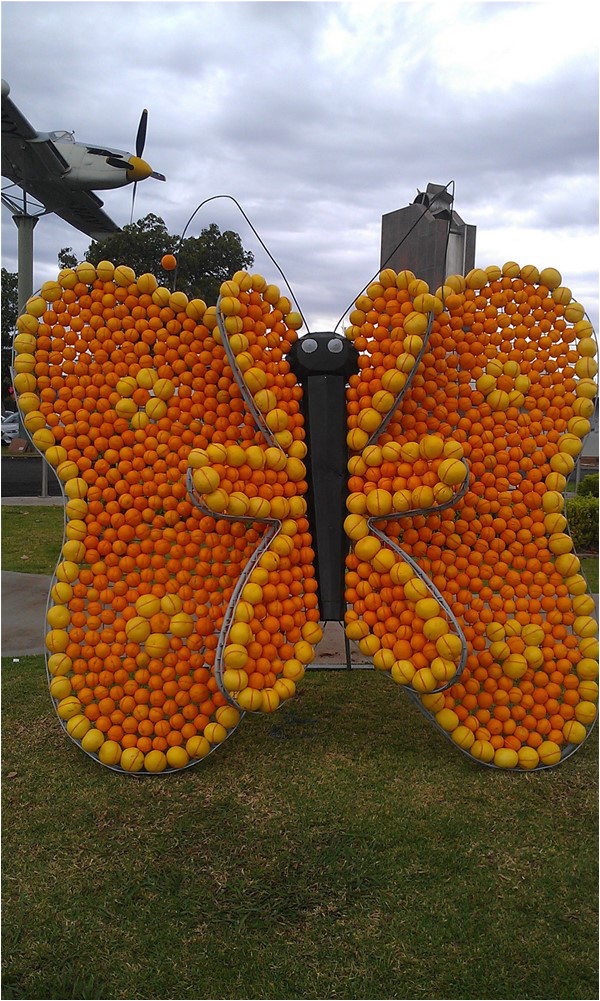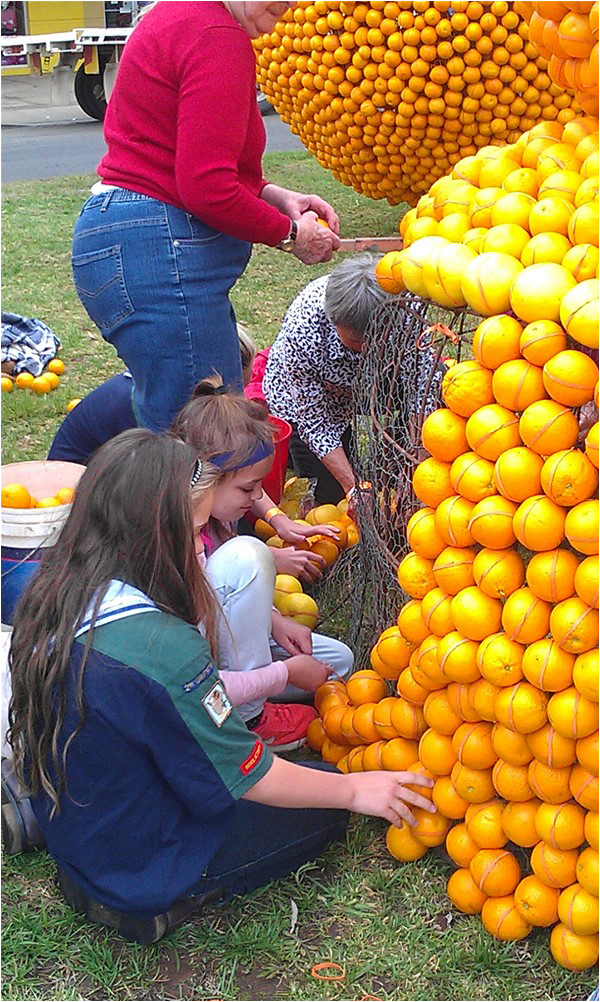
Griffith is a small town in the interior of New South Wales state of Australia. It is an agricultural region with vast and numerous vineyards, citrus orchards, almond fields and livestock farms. The area, known as Riverina, lies in the northern part of the Murray-Darling basin along the Murrumbidgee River, one of the major tributaries. Agriculture in this semi-arid area has become possible due to the irrigation canals laid out to channelise the waters stored in Burrinjuck Dam over the Murrumbidgee River and Blowering Dam over the Tumut River, a smaller tributary of the Murrumbidgee.
The area is the food basket of Australia and produces prodigious quantities of rice, cotton, wheat, vegetables, melons, strawberries and other agricultural products of every kind. The local industry, too, is farm-based and includes chicken processing, juice extraction and ginning factories. The town and its surrounding villages have a large number of wineries. One in every four bottles of wine produced in Australia is brewed in Griffith – including the world famous ‘Yellow Tail’ brand.

Griffith is orange country, much like our Sargodha. The town is surrounded by extensive orange farms, some one to two kilometres square in area. Driving south to Melbourne, or east to Canberra/Sydney, or northeast to Brisbane or west to Hay, one passes by kilometre after kilometre of orange farms on both sides of the roads. In the right season, the trees are laden with the delicious and juicy bright yellow fruit. The oranges grown here are of two varieties: ‘Navel’ that ripens in winter, has fewer seeds and is sweet, and ‘Valencia’ that ripens in summer, is very juicy, thin-skinned and favoured by juice companies.”
To celebrate and showcase its most cherished produce, Griffith has been holding a yearly orange festival for the last fifteen years. It starts on the second Sunday of October and continues through the week.

For the festival, many of the local schools, clubs, businesses and organisations have manufactured iron bar frames, called statues/sculptures that are covered with thick steel mesh. On the festival Sunday, the frames are placed on the road divider in the centre of town’s main avenue and some on its wide green area. Employees of the businesses and members of clubs, organisations and schools gather at seven in the morning to decorate their statues. Many volunteers from the town, including senior citizens, young persons and children, join in for the activity.
The statues are built to depict their sponsors. The Music Club has a guitar, the Sports Shoes shop has a shoe, the Seniors Club has an owl, the Fire Department has a fire truck, another Music Club has a Piano, a resort hotel has a butterfly, the Citrus Growers Group has an orange (of course!), a school has a book and so on. In all there are about three dozen statues.
I joined a wheat/sheep grower neighbour of mine who maintains one of the statues. We drove in his double cabin, with the statue secured at the back, at sunrise in the morning. Volunteers had already gathered at the venue. A portion of the road had been closed by the police using road barriers, allowing only vehicles carrying statues or oranges to go through. Large plastic containers, with capacity of about 500 oranges, had been placed at regular intervals. Each statue was supplied with bags of rubber bands. We looped rubber bands through the mesh and pulled them over oranges to let them hang. The rubber bands were tied about 4 inches apart all around the statues and oranges were hung from them. Grapefruits were used to demarcate special features, like the wheels of a vehicle or the wings of a bird/butterfly. The oranges were fixed starting from the bottom and gradually moved up. When the oranges were fixed at higher locations, ladders were used to reach the top of the statues. Volunteers had brought plastic buckets to fetch oranges from the large containers to their statues and kept up a regular supply.

The oranges, grapefruits and rubber bands are supplied by a local juice extraction company. Close to a hundred thousand oranges and rubber bands are used. The company also provides free juice to volunteers throughout the three hours that it takes to populate the statues. The Lions Club arranges free sausages. I had to forego the sausage part because I was told that they contain pork mince. The juices were kosher for me, of course!
The festival lasts ten days. A large number of people from the town and the nearby villages come to witness the display. At the end of the week, the frames are put in store for the year. In case you are wondering about the fate of the huge quantity of oranges and grapefruits; well, they are collected back by the juice company and crushed for juice.
One thing that bothered me was that I did not see any person of Asian heritage participating in the orange fixing activity, though there is a large population of Indian, Pakistani, Turkish, Malaysian and Indonesian background. To me, at least, this speaks poorly about their motivation to integrate into their adopted country.
Having participated in the festival throughout its duration, I was wondering if the growers, traders, packers and exporters of kinno in Pakistan can organise such a fair in Sargodha along Ketchry Bazaar or in Company Bagh. This would serve to highlight our orange crop, encourage tourism, provide entertainment, boost the local economy and bring the name of the city into the limelight.
Parvez Mahmood retired as a Group Captain from PAF and is now a software engineer. He lives n Islamabad and can be reached at parvezmahmood53@gmail.com
The area is the food basket of Australia and produces prodigious quantities of rice, cotton, wheat, vegetables, melons, strawberries and other agricultural products of every kind. The local industry, too, is farm-based and includes chicken processing, juice extraction and ginning factories. The town and its surrounding villages have a large number of wineries. One in every four bottles of wine produced in Australia is brewed in Griffith – including the world famous ‘Yellow Tail’ brand.

Griffith is orange country, much like our Sargodha. The town is surrounded by extensive orange farms, some one to two kilometres square in area. Driving south to Melbourne, or east to Canberra/Sydney, or northeast to Brisbane or west to Hay, one passes by kilometre after kilometre of orange farms on both sides of the roads. In the right season, the trees are laden with the delicious and juicy bright yellow fruit. The oranges grown here are of two varieties: ‘Navel’ that ripens in winter, has fewer seeds and is sweet, and ‘Valencia’ that ripens in summer, is very juicy, thin-skinned and favoured by juice companies.”
To celebrate and showcase its most cherished produce, Griffith has been holding a yearly orange festival for the last fifteen years. It starts on the second Sunday of October and continues through the week.

For the festival, many of the local schools, clubs, businesses and organisations have manufactured iron bar frames, called statues/sculptures that are covered with thick steel mesh. On the festival Sunday, the frames are placed on the road divider in the centre of town’s main avenue and some on its wide green area. Employees of the businesses and members of clubs, organisations and schools gather at seven in the morning to decorate their statues. Many volunteers from the town, including senior citizens, young persons and children, join in for the activity.
The statues are built to depict their sponsors. The Music Club has a guitar, the Sports Shoes shop has a shoe, the Seniors Club has an owl, the Fire Department has a fire truck, another Music Club has a Piano, a resort hotel has a butterfly, the Citrus Growers Group has an orange (of course!), a school has a book and so on. In all there are about three dozen statues.
I joined a wheat/sheep grower neighbour of mine who maintains one of the statues. We drove in his double cabin, with the statue secured at the back, at sunrise in the morning. Volunteers had already gathered at the venue. A portion of the road had been closed by the police using road barriers, allowing only vehicles carrying statues or oranges to go through. Large plastic containers, with capacity of about 500 oranges, had been placed at regular intervals. Each statue was supplied with bags of rubber bands. We looped rubber bands through the mesh and pulled them over oranges to let them hang. The rubber bands were tied about 4 inches apart all around the statues and oranges were hung from them. Grapefruits were used to demarcate special features, like the wheels of a vehicle or the wings of a bird/butterfly. The oranges were fixed starting from the bottom and gradually moved up. When the oranges were fixed at higher locations, ladders were used to reach the top of the statues. Volunteers had brought plastic buckets to fetch oranges from the large containers to their statues and kept up a regular supply.

The oranges, grapefruits and rubber bands are supplied by a local juice extraction company. Close to a hundred thousand oranges and rubber bands are used. The company also provides free juice to volunteers throughout the three hours that it takes to populate the statues. The Lions Club arranges free sausages. I had to forego the sausage part because I was told that they contain pork mince. The juices were kosher for me, of course!
The festival lasts ten days. A large number of people from the town and the nearby villages come to witness the display. At the end of the week, the frames are put in store for the year. In case you are wondering about the fate of the huge quantity of oranges and grapefruits; well, they are collected back by the juice company and crushed for juice.
I was wondering if the growers, traders, packers and exporters of kinno in Pakistan can organise such a fair in Sargodha
One thing that bothered me was that I did not see any person of Asian heritage participating in the orange fixing activity, though there is a large population of Indian, Pakistani, Turkish, Malaysian and Indonesian background. To me, at least, this speaks poorly about their motivation to integrate into their adopted country.
Having participated in the festival throughout its duration, I was wondering if the growers, traders, packers and exporters of kinno in Pakistan can organise such a fair in Sargodha along Ketchry Bazaar or in Company Bagh. This would serve to highlight our orange crop, encourage tourism, provide entertainment, boost the local economy and bring the name of the city into the limelight.
Parvez Mahmood retired as a Group Captain from PAF and is now a software engineer. He lives n Islamabad and can be reached at parvezmahmood53@gmail.com

